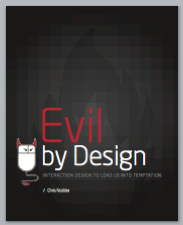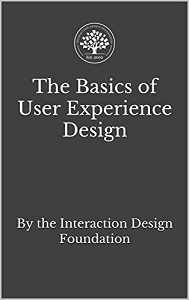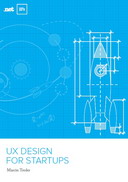
|
FreeComputerBooks.com
Links to Free Computer, Mathematics, Technical Books all over the World
|
|
- Title: Evil by Design: Design Patterns that Lead Us into Temptation
- Author(s) Chris Nodder
- Publisher: Wiley, 1 edition (June 17, 2013); EvilByDesign.info (2012)
- Paperback: N/A
- eBook: PDF
- Language: English
- ISBN-10: 1118422147
- ISBN-13: 978-1118422144
- Share This:

|
Learn how companies make us feel good about doing what they want. Approaching persuasive design from the dark side, this book melds psychology, marketing, and design concepts to show why we're susceptible to certain persuasive techniques. Packed with examples from every nook and cranny of the web, it provides easily digestible and applicable patterns for putting these design techniques to work. Organized by the seven deadly sins, it includes:
- Pride -- use social proof to position your product in line with your visitors' values
- Sloth -- build a path of least resistance that leads users where you want them to go
- Gluttony -- escalate customers' commitment and use loss aversion to keep them there
- Anger -- understand the power of metaphysical arguments and anonymity
- Envy -- create a culture of status around your product and feed aspirational desires
- Lust -- turn desire into commitment by using emotion to defeat rational behavior
- Greed -- keep customers engaged by reinforcing the behaviors you desire
- Chris Nodder wants to spread the word about User Centered Design.
- Software Design Patterns
- Website Style, Design and Accessibility
- Visualization and GUI (Graphic User Interface) Programming
- Software Engineering Principles and Practices

- Evil by Design: Design Patterns that Lead Us into Temptation (Chris Nodder)
- The Mirror Site (1) - PDF
- Evil by Design? How Interaction Design Can Lead Us into Temptation
-
 The Design Of Everyday Things (Don Norman)
The Design Of Everyday Things (Don Norman)
This book melds psychology, marketing, and design concepts to show why we're susceptible to certain persuasive techniques. Packed with examples from every nook and cranny of the web, it provides easily digestible and applicable patterns.
-
 Design: Creation of Artifacts in Society (Karl Ulrich)
Design: Creation of Artifacts in Society (Karl Ulrich)
This book provides a unifying framework for understanding how artifacts are created in society. The treatment includes both a discussion of elements of design process as well as topical issues.
-
 Flourish by Design (Nick Dunn, et al)
Flourish by Design (Nick Dunn, et al)
This book brings together a range of established and emerging voices in design research for a collection that provides original provocations on topics of global significance. It's an insightful guide to concerning how we can design for a better tomorrow.
-
 Applied Design Research (Peter Joore, et al)
Applied Design Research (Peter Joore, et al)
A Mosaic of 22 Examples, focussing on Bridging the Gap between Practice and Academics. This book builds a bridge between both worlds by showing how design and research can be integrated to develop a new field of knowledge.
-
 The Shape of Design (Frank Chimero)
The Shape of Design (Frank Chimero)
Instead of talking about typography, grids, or logos, this book focuses on storytelling, co-dependency, and craft. It tries to supplement the abundance of technical talk and how-to elsewhere by elevating why great work is done.
-
 The Fable of the User-Centered Designer (David Travis)
The Fable of the User-Centered Designer (David Travis)
User-centred design is ostensibly simple, yet when it comes to great user experiences many people do it incorrectly. After reading this book, you'll understand the framework of user-centred design and know how to apply it to your own design project.
-
 Domain-Driven Design Quickly (Abel Avram, et al)
Domain-Driven Design Quickly (Abel Avram, et al)
This book is a short, quickly-readable summary and introduction to the fundamentals of Domain Driven Design (DDD), it does not introduce any new concepts; it attempts to concisely summarize the essence of what DDD is, drawing mostly the original book.
-
 Data-Oriented Design (Richard Fabian)
Data-Oriented Design (Richard Fabian)
This book is a practical guide for serious game developers. It is for game developers working to create triple A titles across multiple platforms, for independent developers trying to get the most out of their chosen target hardware, in fact for anyone who develops cutting edge software in restrictive hardware.
-
 Designing Interfaces: Patterns for Effective Interaction Design
Designing Interfaces: Patterns for Effective Interaction Design
Thiis is a book about interface and interaction design, structured as a pattern language. It features real-live examples from desktop applications, web sites, web applications, mobile devices, and everything in between - a definitely good book to study before new apps.
-
 The Basics of User Experience (UX) Design by Mads Soegaard
The Basics of User Experience (UX) Design by Mads Soegaard
If you're looking to gain an introduction into the world of user experience (UX) design - or maybe even freshen up your knowledge of the field - then this UX design book is the ideal place to start.
-
 UX Design for Startups (Marcin Treder)
UX Design for Startups (Marcin Treder)
Creating a great user experience doesn't have to be a lengthy or expensive process. This hands-on book shows you how to use Lean UX techniques to do it faster and smarter, and build something your customers will truly love.
-
 Designing Virtual Worlds (Richard A. Bartle)
Designing Virtual Worlds (Richard A. Bartle)
This book is the most comprehensive treatment of Virtual World design to-date from one of the true pioneers and most sought-after design consultants. It brings a rich, well-developed approach to the design concepts behind virtual worlds.
-
 Access by Design: A Guide to Usability for Web Designers
Access by Design: A Guide to Usability for Web Designers
This book demonstrates how to create sites in which any user, regardless of accessibility needs, can access every element, even if they have an outdated search engine, slow modem, small device, or other less-than-optimal conditions.
-
 Working through Screens (Jacob Burghardt)
Working through Screens (Jacob Burghardt)
This book is a reference for product teams creating new or iteratively improved applications for thinking work. It helps definers and designers to explore innovative new directions for their products.





